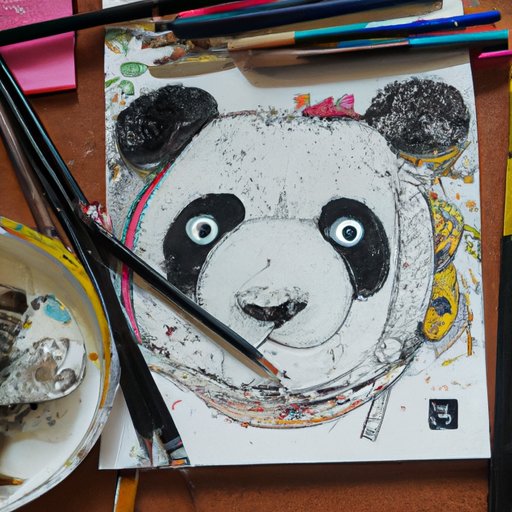
How to Draw a Panda: Tips and Tricks for Every Skill Level
Are you looking for a fun and creative way to unwind after a long day? Drawing can be a great way to relax and express yourself, and what better subject to draw than the adorable and beloved panda?
Easy Step-by-Step Guide: How to Draw a Cute Panda
If you’re new to drawing, you may want to start with a simple, cartoon-like panda. Here is a step-by-step guide to help you get started:
- Draw a large circle for the head and a smaller circle for the body.
- Add two small circles for the ears and two smaller ovals for the arms.
- Add two dots for the eyes, a small triangle for the nose, and a curved line for the mouth.
- Draw two large ovals for the legs and add paws to each foot.
- Finally, draw bamboo shoots around your panda to create a cute scene.
Remember to erase any unnecessary lines as you go along and use a light pencil to sketch, so you can easily make changes if needed. If you find it difficult to draw freehand, try using a stencil or template as a guide.
Master the Art of Drawing a Realistic Panda with These Simple Tips
If you’re ready to take your panda drawing to the next level, here are some tips for adding detail and texture to make it look more realistic:
- Start with a light pencil sketch and build up the details slowly.
- Pandas have thick, furry coats, so use short, soft strokes to create a fluffy texture.
- Use dark lines to emphasize the sharp features of the face, such as the eyes, nose, and mouth.
- For shading, use a range of pencils, from soft to hard, and vary the pressure to create depth and contrast.
- Don’t be afraid to erase and start over if something doesn’t look right.
Remember, practice makes perfect, so keep experimenting until you find the style that works best for you.
Get Creative with These Unique Methods for Drawing a Panda
If you want to try something different, here are some unconventional materials or methods you can use:
- Use watercolors to create a soft, dreamy effect.
- Draw on a chalkboard for a whimsical, playful look.
- Try sketching with a charcoal pencil for a smudged, rustic feel.
- Use colored pencils to create a bold, vibrant image.
Don’t be afraid to experiment with different combinations of materials and techniques to create a panda drawing that is unique and personalized.

From Sketch to Finish: How to Draw a Panda in Four Easy Stages
If you prefer a more structured approach, here is a four-stage process for drawing a panda:
- Start with basic shapes to create the body and head.
- Add the details, such as the eyes, nose, and mouth, and sketch in the fur lines.
- Shade in the fur with short, soft strokes to create texture and depth.
- Finish with highlights and final touches to bring your drawing to life.
Remember to take your time and work gradually, being patient and persistent will make the final result even sweeter.
The Ultimate Guide to Drawing Pandas: Techniques and Tricks for Every Skill Level
If you want a comprehensive guide to drawing pandas, here is a summary of the key techniques and tips from earlier topics:
- Start with basic shapes and work up to the details.
- Use short, soft strokes to create a fluffy texture for the fur.
- Vary your pencils to create depth and contrast.
- Experiment with different materials and techniques to find your own style.
For each technique, you can adjust it for different skill levels. Beginners can start with simpler shapes and lines and gradually build up, while more advanced artists can use more complex techniques for shading and detail.

Discover Your Inner Artist: Drawing a Panda with Unconventional Materials
If you still want to explore unconventional methods and materials, here are some more ideas:
- Use pastels to create a soft, dreamy effect.
- Draw on black paper for a dramatic, high-contrast image.
- Try using a ballpoint pen for a clean, crisp look.
- Experiment with different brush sizes and techniques when using watercolors.
The possibilities are almost endless, so don’t be afraid to think outside the box and come up with your own unique methods for drawing pandas.
Conclusion
Drawing pandas can be a fun and rewarding way to exercise your creativity and express yourself. Whether you’re a beginner or an experienced artist, there are many different techniques and materials you can use to create a panda drawing that is uniquely yours. We hope this guide has given you some inspiration to get started, and we encourage you to keep practicing and expanding your skills.
